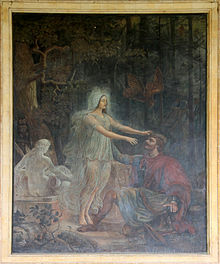Burkart Keller
The Junker Burkart Keller von Yburg is a legendary figure from Baden . The legend about his person is one of the fourteen motifs that are depicted as frescoes in the Baden-Baden drinking hall .
action
Burkart Keller served as a cavalier together with some servants and the guards at Hohenbaden Castle for the widowed margravine . His fiancée Clara von Tiefenau, daughter of the margrave's seneschal , lived in the official city of Kuppenheim , and Keller often wandered through the forest to see her, mostly early in the morning or late at night.
One night as he was walking home, as usual, the lonely and gloomy path through the pine forest and the horn of the outpost of the castle had just announced midnight , he saw with astonishment in the bright moonlight a veiled lady standing by the roadside, not far from him, dressed in silky linen robe. It's not a ghost , he thought to himself. Adventurous, he approached the lonely figure. But as he got closer, the beautiful contours of the mysterious personality disappeared, until it finally disappeared completely like an illusion when he reached out his arm to her. The knight felt a mysterious shudder now, but his courageous heart and his reckless mind convinced him that it was nothing more than an imagination.
To make sure of this he went the same way and at the same hour the following night. The airy figure was in the same place as the night before. But this time she was not wrapped in linen, the veil was removed, her head rested on her hand and a fresh wind played happily with her long auburn locks, which covered her luscious bosom and white shoulders. The cavalier hesitated for a moment. But then he rebuked himself for his cowardice, approached the lady, and a second time she disappeared like an air spirit .
At home he spoke of this experience with the castellan , an old and wise man. He told him that a temple of a pagan idol had been built at the place where he had seen the ghost . And no one, he added, dared to go past this place at the witching hour.
The young knight was not known to be either superstitious or a coward . So the next morning he ordered that digging be done at the place where the mysterious phantom had appeared to him.
After some digging and searching, a small Roman altar was discovered, dedicated to the nymphs of the forest, and a little deeper a beautiful marble statue . Despite the mutilated arms, it was probably impossible to have seen a more beautiful and admirable head of a young woman. The Cavalier ordered that the altar and the statue would be built at this place again, and from that day on was this the name Keller image coordinates: 48 ° 46 '57.1 " N , 8 ° 14' 15.1" O .
But what followed was sadness . The marble fairy nymph took complete possession of the knight's heart and kindled a delusional love in the young man's chest. Seized by an indescribable passion for the enchanting marble statue, he went to see her again at midnight. The moon shone brightly and lit his way. The fairy nymph, as he had seen her twice before, sat at the foot of the pagan altar. But this time she did not disappear as before when the knight approached her. She became more and more visible and real as he got closer to her, and he could see her enchanting features, her blooming face and all her beauty. Her figure appeared even more beautiful to him and her light linen dress revealed more than that it hid the delicate contours of the young person.
A courageous servant of the castle secretly followed his adventurous master out of curiosity and stopped at some distance from that place. Here he saw the gentleman deep in conversation with the fairy young woman. However, when he took her hand and dared to take her impetuously in his arms, he could no longer hold back. The woman did not break away from the embrace, but looked at him with a childlike smile, allowed him to press his lips and kiss her. The old servant was so worried about this that he dared not stay in this place any longer. He fled hastily and did not rest until he saw the gray battlements of the castle. The next morning, however, the knight was found dead on the ground some distance from the altar. The marble statue was gone.
When Keller's brother found out about this, he had the altar destroyed and removed and a crucifix erected in its place. And at the place where the body of the knight had been found, he had another symbol of Christian veneration put up, a stone cross with the inscription BURKART KELLER.
The Kellerskreuz is still there today, about 600 m from Kellersbild on the way to the castle. The approximately one kilometer long forest path from Kellerskreuz to the Old Castle is now called the Kellerskreuzweg .
Kellersbild is now a popular destination for hikers; today there is a wayside shrine with an image of Mary . Kellersbild is located between Hardberg and Battert at a crossroads to the Old Castle (Hohenbaden) and the Baden-Baden districts of Ebersteinburg , Haueneberstein , Balg and Weststadt . The way to the Weststadt is called Kellersbildweg ; it runs south along the Hardberg and ends at the Bernhardus Church .
swell
- Charles Francis Coghlan: The Beauties of Baden-Baden and its Environs. F. Coghlan, London 1858, pp. 91-94 ( digitized in the Google book search).
- August Schnezler (Ed.): Badisches Sagen-Buch. Second division: From the Ortenau to the Mainthal. Creuzbauer and Kasper, Karlsruhe 1846, pp. 199–202 ( digitized in the Google book search).

